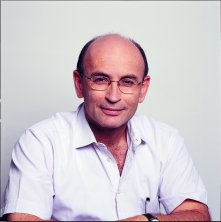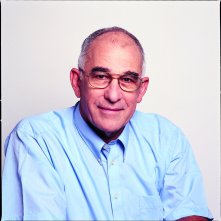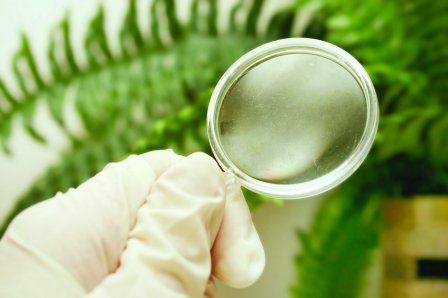Research led by Prof. Avigdor Scherz of the Weizmann Institute of Science Department of Plant Sciences and Prof. Yoram Salomon of the Institute’s Department of Biological Regulation, Israel, is coming to fruition in a potential new treatment for prostate cancer. “This therapy requires knowledge of physics, chemistry and biology, as well as scientific methods of the twenty-first century,” Prof. Scherz said during a recent visit to the offices of the American Committee for the Weizmann Institute of Science (ACWIS) in New York.


The treatment, which is now entering Phase II/III clinical trials, is being conducted on people who failed to respond to radiation therapy. Patients are injected with a solution containing a modified form of bacteriochlorophyll (chlorophyll from bacteria)—the pigments found in photosynthetic bacteria that harness solar energy for driving carbohydrate synthesis. The drug stays in the blood vessels for a short time before clearing from the body. When exposed to fiber-optic laser light, which is easily absorbed by the bacteriochlorophyll, the drug reacts with oxygen to create toxic molecules. Exposing the tumor blood vessels to such illumination after injection causes their destruction, and subsequent cancer cell death due to oxygen and nutrient deprivation.
Prof. Scherz and his colleagues hope that this vascular targeting photodynamic treatment (VTP) can be used as a first-line therapy for prostate cancer. If this is accomplished, patients could avoid surgery or radiation, which can cause side effects that negatively impact sexual function and quality of life. In the Phase II studies, which are sponsored by Steba Biotech of France, the treatment destroyed cancerous tissue and spared vital organs, such as the urethra, in men with prostate cancer who had not benefited from prior radiation therapy. VTP took an average of 20 minutes and did not cause significant side effects. Approximately 50% of the patients appear disease free at one year after a single treatment.
One advantage that this treatment has over other forms of photodynamic therapy (PDT) is that the chlorophyll-containing drug clears the system within hours, rather than days. This helps to reduce side effects to the skin, such as sunburn, and should allow for multiple treatments within a short period of time, explains Prof. Scherz. Additionally, one optic fiber is able to treat a tumor up to 3 to 4 centimeters in diameter, which is larger than tumors treatable by conventional PDT.
Researchers also plan to treat about 30 patients in a clinical trial in England. These men are not undergoing any treatment for prostate cancer, other than watchful waiting to make sure the disease doesn’t spread. They want to avoid surgical removal of the prostate and receive the bacteriochlorophyll-based PDT. Prof. Scherz hopes that this form of PDT for prostate cancer will be available in the United States, England, France, Canada, and Israel in the near future. In the meantime, he and his colleagues are evaluating how this treatment might help treat breast, liver, pancreatic, kidney, and brain cancers. “The therapy will have to undergo modification for each type of cancer,” he explains.

Prof. Scherz points out that the strides in his research would not have been possible outside of the special habitat of the Weizmann Institute. The congregation of different disciplines within a supportive multidisciplinary infrastructure allowed for the rapid development and implementation of the project.
To better benefit from the PDT modality, researchers have to understand the ways some molecules, when excited by light, transfer energy to create radicals. (Radicals are entities that are able to destroy larger chemical entities, such as proteins or membrane lipids.) Then researchers must decipher the impact of such processes on the tumor tissue and normal blood tissues and, finally, define the treatment targets—cells, blood vessels, interstitial tissue.
Prof. Scherz explains, “We then asked ourselves—first, how can we make PDT with the new reagents and, second, how can we make this general modality most effective?” They arrived at the idea of targeting the tumor vessels with molecules that will not leave the blood vessels, but will clear rapidly from the treated patients. Chlorophylls of photosynthetic bacteria appeared to be the best choice, as nature adapted them for efficient light harvesting and radical production at near-infrared, where light penetrates deeply into animal tissues.
Creating a team that could meet on a daily basis to answer such questions was crucial, and the readiness of researchers and students at the Weizmann Institute to enter such multidisciplinary efforts made it easy. Profs. Scherz and Salomon succeeded in gathering students with experience in chemistry, as well as staff scientists and colleagues in biology and physics. The Institute’s technology transfer arm, Yeda Research and Development, provided the critical connection to the pharmaceutical industry, and Steba Biotech undertook the development of Tookad, the first candidate in the modified-chlorophyll series.
Prof. Scherz concludes, “The Weizmann Institute helps to bring ideas forward and helps those ideas become realized.”
Prof. Avigdor Scherz is the incumbent of the Robert and Yadelle Sklare Chair in Biochemistry.Prof. Yoram Salomon is the incumbent of the Charles W. and Tillie K. Lubin Chair of Hormone Research. The Weizmann Institute of Science in Rehovot, Israel, is one of the world's foremost centers of scientific research and graduate study. The American Committee for the Weizmann Institute of Science is a community of dedicated people who share a common vision in support of the Institute. The generous assistance the Institute receives from individuals, foundations, and corporations is vital for its future. Committee members show their devotion to the advancement of the Institute's goals by becoming partners in the search for answers to the most difficult challenges facing humanity.
